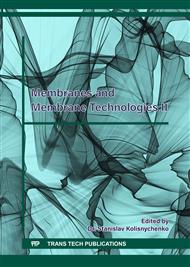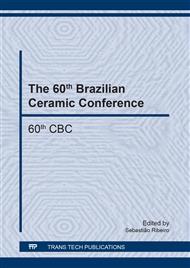p.224
p.230
p.234
p.240
p.245
p.251
p.257
p.263
p.269
Alumina Membrane Development with Carbon Fiber as Porosity Precursor
Abstract:
Alumina membrane for microfiltration has been studied by introduction of carbon fiber as porogenic agent. Ceramic membranes have advantages due to its inert chemical and resistance to relatively high temperatures, however, being porous, tend not to withstand high pressures. This work investigates the possibility of introducing carbon fibers so, after firing, rest communication channels and owing to the increased probability of contact between fibers, achieve high permeability with maintaining the mechanical strength. Formulations were proposed with variations of fiber length, concentration and burn at two temperatures. They were characterized by linear shrinkage, porosity, density, permeability, 3 points flexural strength, SEM and MicroCT. The Taguchi method correlated the parameters: fiber length, fiber concentration and burn temperature and validated by ANOVA. The combination that best met the commitment was 3% v/v of 1mm fibers and burnt at 1500°C, with Darcyana permeability of 3.44 10-15m2 and fracture stress of 56.27MPa.
Info:
Periodical:
Pages:
245-250
Citation:
Online since:
January 2018
Keywords:
Price:
Сopyright:
© 2018 Trans Tech Publications Ltd. All Rights Reserved
Share:
Citation:




